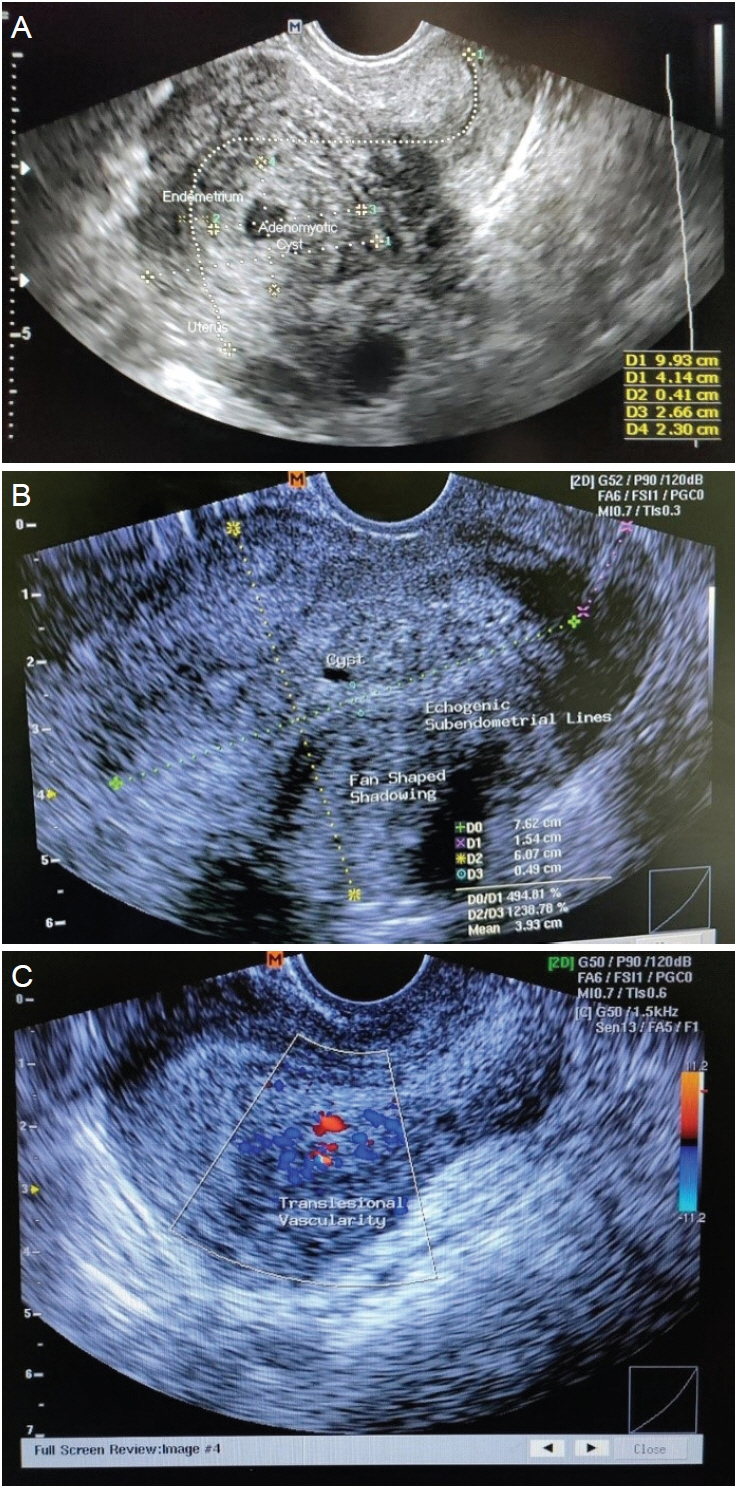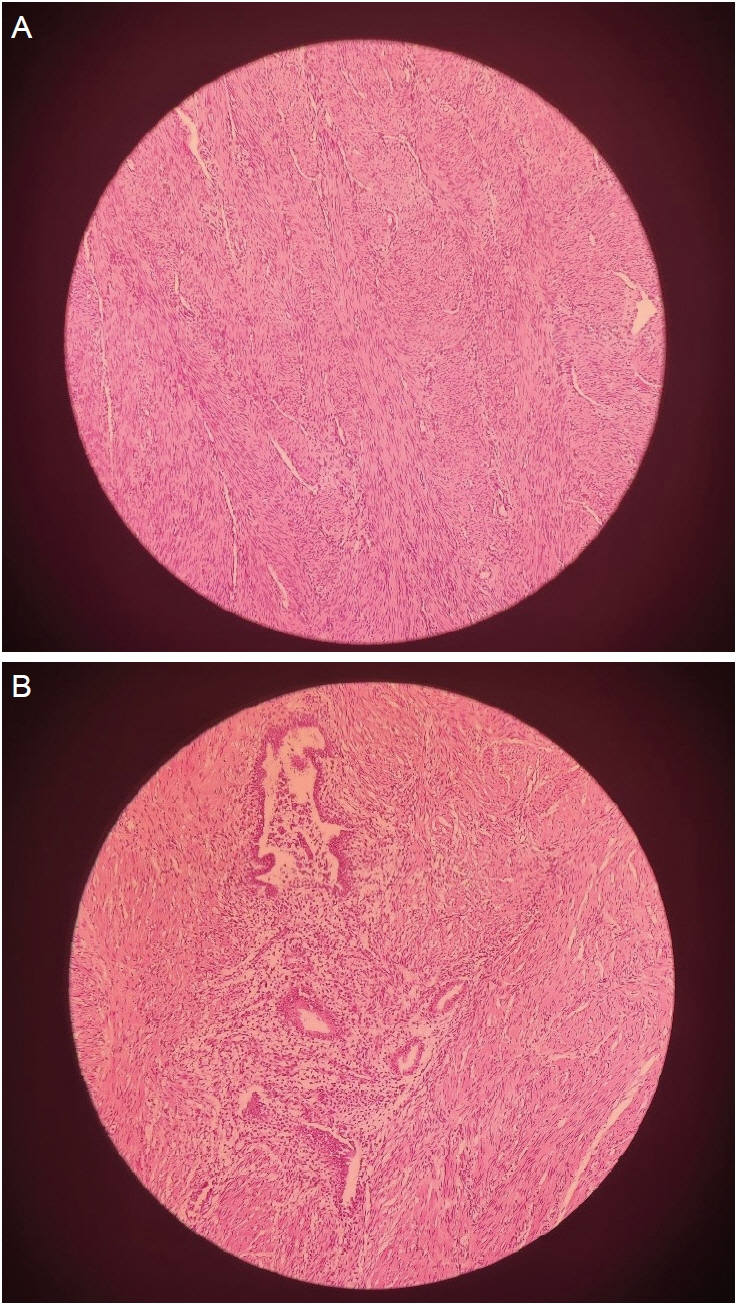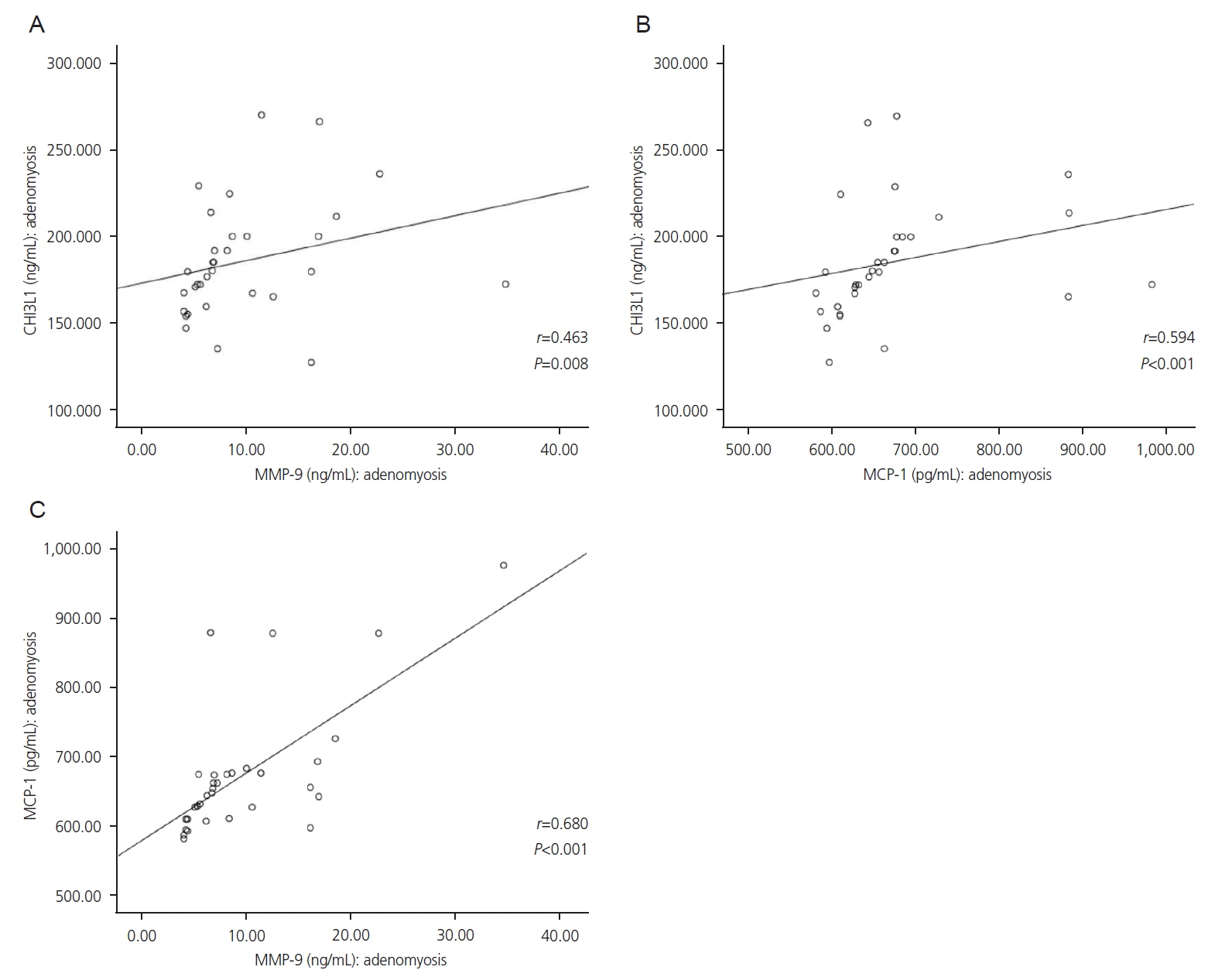Obstet Gynecol Sci.
2024 Jul;67(4):421-429. 10.5468/ogs.24021.
Chitinase-3-like protein 1, matrix metalloproteinase-9, and monocyte chemoattractant protein-1 as potential biomarkers and treatment targets of adenomyosis
- Affiliations
-
- 1Reproductive Endocrinology and Infertility Subdivision, Department of Obstetrics and Gynecology, Padjadjaran University Medical School, Hasan Sadikin Hospital, West Java, Indonesia
- 2Reproductive Endocrinology and Infertility Subdivision, Department of Obstetrics and Gynecology, Udayana University Medical School, Prof. Ngoerah Hospital, Bali, Indonesia
- KMID: 2557859
- DOI: http://doi.org/10.5468/ogs.24021
Abstract
Objective
This study aimed to investigate the levels of chitinase-3-like protein-1 (CHI3L1), matrix metalloproteinase-9 (MMP-9), and monocyte chemoattractant protein-1 (MCP-1) in adenomyosis, as compared to normal myometrial tissue. These biomarkers may be useful for determining potential treatment targets.
Methods
This was a correlative, analytical, and observational study with a cross-sectional design. Participants with a diagnosis of moderate-to-severe adenomyosis, as determined through transvaginal ultrasonography and histological examination, and who underwent laparotomy or laparoscopic surgery for the treatment of adenomyosis, were enrolled in the study. Unlike other studies that recruited healthy women as controls, our study used adenomyotic and healthy nonadenomyotic myometria obtained from the same individual. The levels of CHI3L1, MMP-9, and MCP-1 in the biopsy samples were determined using enzyme-linked immunoassay kits, according to the manufacturer’s protocol.
Results
A highly significant increase in the levels of CHI3L1, MMP-9, and MCP-1 was found in adenomyotic tissues compared to non-adenomyotic tissues (P<0.001). A significant positive correlation was found between CHI3L1 and MMP-9 levels (r=0.463; P=0.008), CHI3L1 and MCP-1 levels (r=0.594; P<0.001), and MCP-1 and MMP-9 levels (r=0.680; P<0.001) in adenomyotic tissues.
Conclusion
CHI3L1 may play a role in the pathogenesis of adenomyosis via the regulation of the MCP-1 and MMP-9 pathways. Therefore, these molecules may serve as biomarkers and potential therapeutic targets for adenomyosis.
Keyword
Figure
Reference
-
References
1. Taylor HS, Pal L, Sell E. Speroff’s clinical gynecologic endocrinology and infertility. 9th ed. Philadelphia: Wolters Kluwer;2019.2. Guo SW. The pathogenesis of adenomyosis vis-à-vis ndometriosis. J Clin Med. 2020; 9:485.3. Jung YM, Wi W, Koo HS, Shim SH, Oh SY, Lee SM, et al. The timing of adenomyosis diagnosis and its impact on pregnancy outcomes: a national population-based study. Obstet Gynecol Sci. 2024; 67:270–8.
Article4. Taran FA, Stewart EA, Brucker S. Adenomyosis: epidemiology, risk factors, clinical phenotype and surgical and interventional alternatives to hysterectomy. Geburtshilfe Frauenheilkd. 2013; 73:924–31.
Article5. Vercellini P, Consonni D, Dridi D, Bracco B, Frattaruolo MP, Somigliana E. Uterine adenomyosis and in vitro fertilization outcome: a systematic review and meta-analysis. Hum Reprod. 2014; 29:964–77.
Article6. Naftalin J, Hoo W, Pateman K, Mavrelos D, Holland T, Jurkovic D. How common is adenomyosis? A prospective study of prevalence using transvaginal ultrasound in a gynaecology clinic. Hum Reprod. 2012; 27:3432–9.7. Upson K, Missmer SA. Epidemiology of adenomyosis. Semin Reprod Med. 2020; 38:89–107.
Article8. Lee JE, Shim S, Chung YJ, Kim MR, Jung CY, Kim S. Epidemiology and recent treatment of leiomyoma, adenomyosis and endometriosis with administrative data in Korean women: a national population-based study. Korean J Obstet Gynecol. 2009; 105:305.9. Naphatthalung W, Cheewadhanaraks S. Prevalence of endometriosis among patients with adenomyosis and/or myoma uteri scheduled for a hysterectomy. J Med Assoc Thai. 2012; 95:1136–40.10. Yu O, Schulze-Rath R, Grafton J, Hansen K, Scholes D, Reed SD. Adenomyosis incidence, prevalence and treatment: United States population-based study 2006-2015. Am J Obstet Gynecol. 2020; 223:94. e1-94.e10.
Article11. García-Solares J, Donnez J, Donnez O, Dolmans MM. Pathogenesis of uterine adenomyosis: invagination or metaplasia? Fertil Steril. 2018; 109:371–9.12. Rossi M, Vannuccini S, Capezzuoli T, Fambrini M, Vannuzzi V, Donati C, et al. Mechanisms and pathogenesis of adenomyosis. Curr Obstet Gynecol Rep. 2022; 11:95–102.
Article13. Benagiano G, Brosens I. History of adenomyosis. Best Pract Res Clin Obstet Gynaecol. 2006; 20:449–63.
Article14. Rižner TL. The important roles of steroid sulfatase and sulfotransferases in gynecological diseases. Front Pharmacol. 2016; 7:30.
Article15. Yeo IJ, Lee CK, Han SB, Yun J, Hong JT. Roles of chitinase 3-like 1 in the development of cancer, neurodegenerative diseases, and inflammatory diseases. Pharmacol Ther. 2019; 203:107394.
Article16. Pouyafar A, Heydarabad MZ, Mahboob S, Mokhtarzadeh A, Rahbarghazi R. Angiogenic potential of YKL-40 in the dynamics of tumor niche. Biomed Pharmacother. 2018; 100:478–85.17. Gschwandtner M, Derler R, Midwood KS. More than just attractive: how CCL2 influences myeloid cell behavior beyond chemotaxis. Front Immunol. 2019; 10:2759.
Article18. Tang CH, Tsai CC. CCL2 increases MMP-9 expression and cell motility in human chondrosarcoma cells via the Ras/Raf/MEK/ERK/NF-κB signaling pathway. Biochem Pharmacol. 2012; 83:335–44.
Article19. Peng Z, Pang H, Wu H, Peng X, Tan Q, Lin S, et al. CCL2 promotes proliferation, migration and angiogenesis through the MAPK/ERK1/2/MMP9, PI3K/AKT, Wnt/β‑catenin signaling pathways in HUVECs. Exp Ther Med. 2022; 25:77.
Article20. Yabluchanskiy A, Ma Y, Iyer RP, Hall ME, Lindsey ML. Matrix metalloproteinase-9: many shades of function in cardiovascular disease. Physiology (Bethesda). 2013; 28:391–403.
Article21. Kobayashi H. Molecular targets for nonhormonal treatment based on a multistep process of adenomyosis development. Reprod Sci. 2023; 30:743–60.22. Vannuccini S, Tosti C, Carmona F, Huang SJ, Chapron C, Guo SW, et al. Pathogenesis of adenomyosis: an update on molecular mechanisms. Reprod Biomed Online. 2017; 35:592–601.
Article23. Fitrina M, Bayuaji H, Madjid TH, Armawan E. Karakteristik pasien adenomiosis dengan gambaran ultrasonografi di rumah sakit dr. hasan sadikin bandung periode 2015-2016. Indones J Obstet Gynecol Sci. 2018; 1:35–9.
Article24. Tan IF, Horne AW. Obesity and chronic pelvic pain. In : Mahmood TA, Arulkumaran S, Chervenak FA, editors. Obesity and gynecology. 2nd ed. Philadelphia: Elsevier;2020. p. 281–91.25. Tuten A, Kucur M, Imamoglu M, Oncul M, Acikgoz AS, Sofiyeva N, et al. Serum YKL-40 levels are altered in endometriosis. Gynecol Endocrinol. 2014; 30:381–4.
Article26. Guo W, Wang J, Wei H. Serum YKL-40 level positively correlates with uterine leiomyomas. Reprod Sci. 2016; 23:1559–64.27. An M, Li D, Yuan M, Li Q, Zhang L, Wang G. Interaction of macrophages and endometrial cells induces epithelial-mesenchymal transition-like processes in adenomyosis. Biol Reprod. 2017; 96:46–57.
- Full Text Links
- Actions
-
Cited
- CITED
-
- Close
- Share
- Similar articles
-
- Expression of Matrix metalloproteinase-1 between Simple Chronic Periodontitis and Type 2 Diabetes associated Chronic Periodontitis on Protein level
- Chitinase, Chitinase-like Protein and Allergic Inflammation
- Biomarkers in Acute Kidney Injury
- EGCC inhibits tumor growth by inbibiting Matrix Metalloproteinase-9 induction in UM-SCC-1 cells
- The Pathogenesis of Adenomyosis Through the Immunohistochemical Study with bcl-2 and MMP-9




